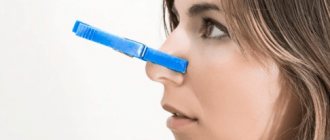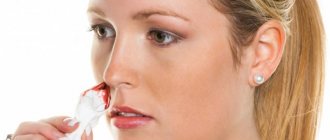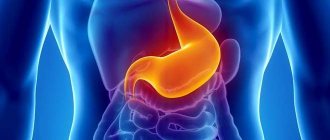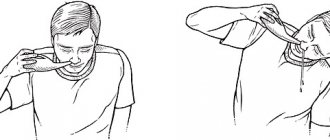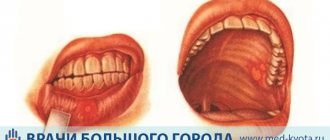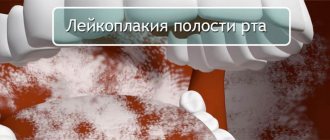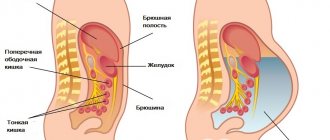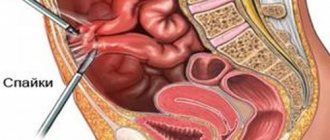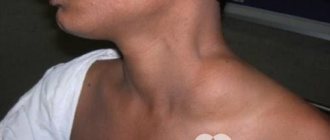Polyps are benign growths arising from the mucous membrane.
Author:
Galkin Alexey Vladimirovich
otorhinolaryngologist, rhinosurgeon
Added information about risk factors for nasal polyps.
Polyps are benign growths of the mucous membrane. Nasal polyps are the result of long-term inflammation in the nose or paranasal sinuses due to prolonged infection, allergens, and certain immune disorders.
Polyps of the nasal cavity and sinuses can appear in both adults and children, but they are more often observed in adults. Drug therapy helps polyps regress in size or slow their growth, but sometimes surgery is performed to relieve the symptoms of the disease. Despite successful treatment, polyps tend to re-grow.
Causes of appearance and main symptoms
For clarity, we will place information about the causes and symptoms of the disease in a table.
| Causes of polyps in the nasal cavity | Symptoms of the disease | Risk group |
|
| Children under the age of 10 years (it is in them that this disease most often occurs). |
Nasal polyps can cause a lot of inconvenience to a person, but the main danger is that benign formations can transform into malignant ones.
They are characterized by gradual growth, so if you do not seek help immediately, polyps can close the entire nasal passage. This is the main reason why nasal polyps need timely treatment.
Surgical intervention is a last resort measure to get rid of the disease, but we will tell you about alternative ways to solve the problem.
Nasal polyps: symptoms
Nasal congestion, difficulty breathing through the nose, decreased sense of smell, snoring, headaches - all these symptoms can provoke nasal polyps.
Polyps sometimes persist for a long time without causing discomfort. However, depending on their location, size and number, they can disrupt the aerodynamics of the nasal cavity and the ventilation of the sinuses. The secretion of mucus in the sinuses and nasal cavity is disrupted, and drainage from the sinuses through the anastomosis becomes difficult. Patients breathe through the mouth rather than through the nose, which typically warms, purifies, and humidifies the breathing air.
All this provokes infection of the nasopharyngeal area. Frequent or persistent chronic sinusitis, recurrent respiratory tract infections (ARI, bronchitis) are the result.
These symptoms may indicate polyps:
- Difficulty breathing and nasal congestion.
- Bad breath due to drying of the oral mucosa - nasal breathing is impaired and patients have to breathe through the mouth.
- Night snoring.
- Nasal voice.
- Olfactory disorders: The sense of smell is impaired or completely lost (because air does not reach the olfactory cells in the upper part of the nasal cavity).
- Pain in the sinuses, constant presence of mucus in the nasopharynx - these symptoms indicate chronic inflammation of the paranasal sinuses - the cause and effect of polyps.
- Nasal polyps occur in children mainly only in diseases such as bronchial asthma, cystic fibrosis or ciliary dyskinesia (see Chapter Causes). If polyps are left untreated in children, they can cause the nose to widen and the distance between the eyes to increase.
Sign up for a consultation
Polyps in a child
The incidence of such diseases as nasal polyps in children is quite high. And it is detected late in children, since at the beginning of its development it does not have obvious and specific symptoms. A number of symptoms that may indicate nasal polyps:
- headache (other causes of headache are described here);
- snore;
- insomnia;
- frequent sneezing;
- smell dysfunction;
- nasal congestion;
- frequent tonsillitis and adenoids;
- voice change;
- pain and sensation of a foreign object in the nose;
- hearing loss.
There are no specific reasons for the formation of nasal polyps in a child, but there are conditions that precede their development: chronic sinusitis or rhinitis, allergic rhinitis, hereditary and congenital predisposition, cystic fibrosis. To establish a diagnosis, the doctor performs rhinoscopy, and tomography to determine the degree of prevalence.
Complications
Nasal polyps can lead to complications because they interfere with the free passage of air and the drainage of mucous secretions from the sinuses.
Possible complications with nasal polyposis:
- Obstructive sleep apnea. In this condition, prolonged pauses in breathing occur during sleep, which increases the risk of cardiovascular disease and sudden cardiac death.
- Progression of bronchial asthma. Polyposis can aggravate the course of bronchial asthma.
- Sinus infection or infectious complications of chronic sinusitis. Nasal polyps increase the frequency of exacerbations of sinusitis and can lead to serious complications (for example, meningitis, orbital phlegmon, sepsis).
Photo - what polyps look like in adults and children
To help the doctor understand what the patient’s polyps look like and how much they have grown, Hartman mirrors are used.
During rhinoscopy, the specialist sees formations in the nose with a smooth surface of a yellow or transparent color, on a stalk. Possible discharge of pus.
What nasal polyps look like in children - the photo is presented below. When examined without tools and apparatus:
What nasal polyps look like in adults - the photo is presented below:
What does a polyp look like from the inside:
Nasal polyps: diagnosis
When examined by an ENT doctor, nasal polyps can be identified visually.
Additional methods, such as computed tomography, provide additional information about the extent of the pathological process. Examination by an ENT doctor.
First, the specialist asks about the patient’s complaints and previous diseases (allergies, sinusitis, etc.). Symptoms such as problems with nasal breathing, impaired sense of smell or frequent sinusitis already raise suspicions about polyposis rhinosinusitis.
Then the doctor carefully examines the ENT organs. Large nasal polyps that protrude into the nasal cavity may already be visible to the naked eye. With the help of speculums and a nasal endoscope, the doctor often finds smaller polyps located more deeply.
Radiation diagnostics.
To obtain accuracy in diagnosis, it is necessary to understand the extent of the spread of polyps in the paranasal region; imaging methods, in particular computed tomography (CT), are suitable for this purpose. Conventional x-rays of the sinuses are considered obsolete. Ultrasound and MRI can be used in the diagnosis of nasal polyps only in rare cases.
Treatment of polyps without surgery
The tricky thing about polyps is that they can grow. Conservative treatment is appropriate only at the initial stage of the disease; in advanced stages, growths must be removed.
Hormone therapy
This type of conservative disposal of polyps involves:
- injection into the body of the neoplasm;
- use of nasal hormonal sprays;
- taking corticosteroids in tablet form.
The term “corticosteroids” refers to medications containing hormonal substances.
Selecting material for injection into a polyp is a scrupulous process that depends on numerous nuances. The principle of this therapy is that the injected drug destroys the polyp cells, which are then removed from the nose with mucus when blowing the nose.
A one-time procedure includes 2 injections. The break between procedures is 2 weeks.
The most commonly prescribed corticosteroid sprays include:
- Aldecin;
- Nasobek;
- Fluticasone, Flixonase, Avamis and Nazarel are a group of medications containing the active ingredient Fluticasone;
- Nasonex (can be prescribed to children over 2 years of age).
The last corticosteroid drug worth mentioning is Prednisolone . It is taken orally. In the first week, the daily dose of medication for an adult is 30-60 mg, in the next 3 weeks the dose is gradually reduced.
All medications containing hormonal substances, regardless of the method of administration (orally, by injection or in the form of sprays), have the same effect. Unfortunately, in quantitative terms, the list of negative consequences of taking corticosteroids exceeds the beneficial properties of drugs.
| The benefits of hormonal medications in the fight against nasal polyps | Side effects of hormonal drugs |
|
|
Hormone therapy does not guarantee getting rid of benign tumors. Having disappeared, polyps can reappear in the nasal cavity after some period of time. This happens when the cause of their initial appearance is not identified and eliminated.
Allergy treatment
The occurrence of nasal polyps is often associated with an allergy to a particular substance.
In this case, therapy consists of 2 stages:
- identification of allergens;
- prescription of antihistamines.
If tests show that the allergen is a substance contained in the food, it is necessary to create a special diet.
When prescribing treatment, experts give preference to modern antihistamines , which have a minimum of side effects. Let's list some of them:
- Levocetirizine;
- Cetirizine;
- Erius;
- Loratadine.
Relief from chronic sinusitis
If chronic sinusitis is the cause of the appearance of a neoplasm, getting rid of it leads to healing from polyps.
In the context of the task at hand, for the treatment of sinusitis, the doctor prescribes:
- antibiotics;
- anti-inflammatory drugs;
- means for auxiliary therapy.
Due to the fact that the list of prescribed drugs is very large, we will place the necessary information in the table.
| Antibiotics | Anti-inflammatory medications | Adjuvant therapy drugs |
|
|
|
Physiotherapeutic procedures
Possible procedures:
- salt inhalations,
- acupuncture,
- ozone-ultraviolet sanitation,
- excision of polyps using laser coagulation (this procedure is performed on an outpatient basis).
Nasal polyps: causes
What causes nasal polyps is not known. But the main risk factors are allergies and chronic rhinosinusitis.
The nasal cavity and paranasal sinuses have a complex self-cleaning mechanism. The cells of the mucous membrane form a thin film of secretion, into which pathogens (viruses, allergens, dust particles) enter from the inhaled air. As a result, the air entering the lungs is purified and moisturized. The cells contain movable hairs (cilia), which transport secretions from the sinuses continuously to the posterior sections of the nasal cavity, from there to the nasopharynx, pharynx, and eventually this mucus enters the acidic environment of the stomach.
Impaired outflow of mucus from the sinuses.
The paranasal sinuses are connected to the nasal cavity through narrow “channels” of the anastomosis. Deviation of the nasal septum and other anatomical features can lead to a narrowing of these “channels”. As a result, discharge accumulates in the sinus cavity and provides ideal soil for the proliferation of pathogenic microorganisms.
Due to frequent infections, the mucous membrane is constantly irritated and swollen - which further aggravates the situation. Polyps may form, which, in turn, further block the outflow from the sinus.
Allergies are a possible precursor to nasal polyps.
Allergies contribute to prolonged irritation and swelling of the mucous membrane in the nasal cavity and sinuses, which can lead to the formation of polyps. Many patients with nasal polyposis simultaneously suffer from various forms of allergies. Even patients without allergies who constantly inhale too dry or polluted air have an increased risk of developing polyps.
Frequent combination: intolerance to analgesics, asthma, polyps (aspirin triad).
People with bronchial asthma are prone to developing nasal polyps, as well as people who cannot tolerate analgesics, specifically non-steroidal anti-inflammatory drugs (NSAIDs). Patients with such NSAID intolerance suffer from asthma attacks as soon as they take certain medications - for example, acetylsalicylic acid (aspirin), ibuprofen, diclofenac, analgin. This is a so-called “pseudo-allergy”; the body does not form specific antibodies against drugs, as with a real allergy.
The combination of NSAID intolerance, nasal polyps and asthma is also called: Samter's triad, Fernand-Vidal triad.
Cystic fibrosis.
Nasal polyps are rare in children—with one exception: About one-third of all children with the congenital metabolic condition cystic fibrosis also develop nasal polyps. With this pathology, the glands secrete an abnormally viscous secretion, which accumulates in the sinuses, which contributes to chronic sinusitis and, consequently, nasal polyps.
A rare cause is primary ciliary dyskinesia.
This is a congenital pathology, which is manifested by underdevelopment of the “cilia” and can manifest itself as frequent respiratory diseases and persistent nasal congestion.
You should be aware that long-term use of vasoconstrictor nasal sprays can affect cilia function in a similar way.
ethnoscience
The most famous methods:
- treatment with celandine juice,
- rinsing the nasal passages with herbal decoctions,
- putting essential oils into the nose.
celandine juice yourself. The plant, dug up along with its roots in May, is washed, put through a meat grinder and infused for a week. After this time, it begins to ferment (a sure sign that the drug is ready). The juice is diluted with water in a 1:1 ratio.
Instill 2 drops into the nostril every morning (regardless of the location of the polyp, both nostrils are subjected to the procedure). The full cycle consists of 5 courses, each of which lasts one week. There is a 10 day break between courses.
Treatment with essential oils lasts even longer: for 6 months, 2 drops of oil from one of the plants are instilled into the nostrils twice a day:
- St. John's wort,
- wild rosemary,
- thuja occidentalis.
Causes
Today, the exact reasons leading to the development of nasal polyps have not yet been identified. Initially, it was believed that the neoplasm appears against the background of allergies. But in recent years, otolaryngology has adhered to the theory of the multifactorial etiology of this disease. The following provoking factors are identified:
- genetic predisposition;
- hay fever, or hay fever;
- prolonged inflammation in the sinuses;
- congenital anomalies of the respiratory system;
- smoking.
Western studies have found that the development of polyps is caused by the body's autoimmune reaction to external and internal threats. In other words, tissues begin to divide pathologically in case of danger, trying to increase the overall size of the mucosa.
The effectiveness of non-surgical treatment
The presented material allows us to conclude that the effectiveness of polyp treatment directly depends on the accurate diagnosis of the cause of its appearance. Eliminating the root cause increases the guarantee of lifelong freedom from unwanted growth.
The fastest non-surgical method of getting rid of a nasal polyp is laser coagulation.
In terms of the degree of destructive impact on nasal tumors, traditional medicine lags many times behind other methods. The optimal area of its application is the prevention of growths.
The decision on the choice of therapy to get rid of nasal polyps should be made only by a doctor.
Nasal polyps have terrible consequences, which is why the appearance of one or more symptoms of this disease is an urgent reason to consult a specialist.
Rhinoscopy, CT, pharyngoscopy - this is an incomplete list of procedures that allow the doctor to find the right solution for getting rid of nasal polyps.
If there are no indications for surgical intervention, based on the individual characteristics of the patient, the doctor will choose the most appropriate method of treating nasal polyps without surgery and, if necessary, select auxiliary therapy drugs.
Prevention
You can reduce your chances of polyps appearing or returning after treatment by following these strategies:
- Monitor allergy symptoms. Follow your doctor's recommendations to monitor the course of your allergic disease. If symptoms do not improve, consult your doctor about changing your treatment.
- Avoid irritants to the nasal mucosa. Avoid contact with substances that can cause inflammation or irritation of the mucous membranes (smoke, a suspension of small particles, caustic chemicals, allergens, dust, animal hair).
- Maintain good hygiene. Wash your hands thoroughly and regularly. This is one of the best ways to prevent infections that can cause inflammation of the mucous membranes of the nasal cavity and sinuses.
- Control the humidity in your home. When humidity levels are low, use humidifiers. This will moisturize the airways and improve self-cleaning of the sinuses and nasal cavity.
- Use nasal cleansers. Use a nasal douche (aerosol) with isotonic sodium chloride solution to clean the cavity. This will reduce the concentration of irritating agents on the nasal mucosa (allergens, dust, germs) and reduce inflammation. If you prepare your own saline solution, use distilled or boiled water.
How to remove nasal polyps: surgical methods
1. Laser polypectomy
The method of removing nasal polyps with a laser has some distinctive features - safety and quick implementation.
Many people have no idea how a doctor removes polyps with a laser, but the method is quite simple: using a laser device and an endoscope, pathological areas are cauterized. The result is achieved after the first session, sometimes the procedure is repeated after a week, an excellent option for treating nasal polyps without pain. After laser removal, free breathing is restored, health changes for the better, and the risk of bleeding and scarring is small.
The cost of treatment varies from 7,000 to 30,000, and the price of laser removal depends on the severity and severity of the disease and the number of surgical interventions.
2. One of the cheapest and first ways to remove nasal polyps is surgical polypotomy. When performing the manipulation, the surgeon uses a special instrument, at the end of which there is a small closed loop. Under local anesthesia, the specialist carefully inserts the instrument into the nasal passage without damaging the polyp and places a loop around its stem. Afterwards the loop is tightened and the polyp is excised.
Unfortunately, the manipulation is quite traumatic - scarring and bleeding are inevitable. Recurrence is also common with the described method. The only advantage is the possibility of free removal upon referral from a local physician.
3. Endoscopic removal
It is distinguished by the possibility of excision of formations in the cavity of the nasal sinuses. Even polyps located in groups can be removed endoscopically. It is characterized by careful removal, leaving no scars and reducing the risk of recurrence. The postoperative period is short. The price is no more than 10,000 rubles.
For more information about the causes of polyps and their treatment, watch the video:
Rate how helpful this article was
3.7 9 people voted, average rating 3.7
Did you like the article? Save it to your wall so you don’t lose it!
Causes
Scientists do not fully understand the reasons for the appearance and growth of polyps. It is not entirely clear why ongoing inflammation triggers the development of polyposis in some people and not in others.
There is some evidence that people who develop polyps have a different immune response and distinctive mucosal chemical markers.
Conditions often associated with polyposis:
- bronchial asthma is accompanied by prolonged inflammation of all airways;
- aspirin sensitivity, intolerance to certain non-steroidal anti-inflammatory drugs causes the development of an inflammatory reaction in the mucous membrane of the respiratory tract in response to medication;
- allergic fungal sinusitis, sensitization of the nasal mucosa and paranasal sinuses to microscopic fungi and their spores;
- cystic fibrosis (cystic fibrosis), a genetic disease that leads to the formation of a very viscous secretion on the mucous membrane of the upper and lower respiratory tract;
- eosinophilic granulomatosis (Charge-Strauss), a rare pathology accompanied by inflammation of blood vessels.
Definition of disease
Polyps are benign formations. They are painless and come in various forms. They can be pea-shaped, but often occur as growths of several polyps, resembling a bunch of grapes or even a mushroom. Polyps form from the connective tissue that lines the respiratory organ. In turn, the upper epithelial layer is covered with microscopic cilia, on which dust, pollen and other allergens are retained when air is inhaled through the nose. And they do not enter the human body further.
In addition, the nose also performs the following important functions:
- Cold air passing through it heats up to body temperature;
- The air resonates when speaking. And we notice when the nose “does not breathe” that a peculiarity of our speech appears - some humming;
- Thanks to the organ of smell, we can distinguish and evaluate the entire palette of smells around us;
- A small amount of mucus is produced, which glues together dust and harmful microorganisms and, thanks to the same cilia, evacuates closer to the exit.
So, if polyps appear in the nose, then the performance of its functions by the organ of smell is very problematic.
Why do these formations appear?
Making a tincture
Celandine tincture is prepared for external use. For 300 ml of boiling water you need a teaspoon of crushed dry celandine. Leave for 20 minutes, use a water bath to heat. After cooling, filter the infusion from the raw materials.
Tampons soaked in the tincture are inserted into the nose. Place tampons one by one. First they put it in one nostril for 10 minutes, then in the other. The course lasts 7 days, after a week of rest it is repeated. Therapy is carried out throughout the year. After every two months, a month's break is taken from the procedures.
Walnut for polyps
The pharmacy sells Todikamp tincture; it is prepared from unripe walnuts. Many people prepare the product themselves. You need to take 10 pieces of green nuts and grind them in a manual meat grinder. Pour in 3 cups of kerosene. Kerosene needs to be purified.
The mixture is infused in a glass container, kept first for 2 weeks in a dark room, then in the light for 1 month. Before use, strain the tincture. It is necessary to instill the product 2 times throughout the day. There are positive reviews on the results of using the drug at home.
Turunda with white lily for polyps
Many people experience a noticeable effect when using white lily tincture. When preparing a folk remedy, vodka is used as a liquid. Before pouring vodka, the lily is crushed. The tincture is prepared for 12 days.
They are treated with turundas soaked in white lily tincture. In order not to burn the nasal mucosa, it is diluted with boiled water; 1 part of boiled water is added to 1 part of the tincture. The procedure with turundas is repeated 3 times throughout the day. Therapy continues for at least a month.
Horsetail for polyps
Good results are obtained when using horsetail decoction at home. It must be said that at least 10 procedures with this product must be performed per day. During the procedure, the broth is drawn into the nostril.
See also
Why does my nose get stuffy after drinking alcohol?
Read
Prepare the decoction fresh every day. Take 2 tbsp per glass of boiling water. l. crushed raw materials into dust, leave for half an hour. Carefully filter the cooled broth from particles of herbs using gauze or a medical bandage, rolled in 3-4 layers.
Diagnostics
Examination of polyps is usually not difficult for an experienced otolaryngologist. The pathology has typical symptoms, but as part of the diagnosis, it is important to exclude a cyst, a malignant tumor, and ordinary chronic inflammation of the sinuses. To determine the size, location and morphological features, visual, laboratory and hardware examination techniques are used.
Rhinoscopy
A key diagnostic method for determining most diseases of the nasal structures. Allows you to determine the nature and shape of the pathology, anatomical location. Rhinoscopy is performed using a special mirror with additional nasopharyngeal and elongated branches. The procedure is completely safe for health and does not cause any discomfort for the patient . Depending on the examination method, posterior, middle and anterior rhinoscopy are distinguished.
CT
Computed tomography (CT) is a comprehensive examination of the nose that combines X-ray equipment and a special computer. Allows you to obtain clear images of internal structures, as well as their shape and size. It is applied for:
- identifying the localization of inflammation;
- determining the surgical plan before surgical removal of the polyp;
- assessment of sinus anatomy, congenital structural defects;
- general diagnosis of the main sinuses.
The advantage of a CT scan of the maxillary sinuses is its high accuracy, the ability to save and print the resulting photographs. The method is considered one of the key ones during preoperative preparation for differentiation from a cyst.
Ultrasound is rarely used to diagnose nasal polyps. Typically, the need for this method arises when neoplastic tissue morphology or the malignant nature of the tumor is suspected.
X-ray
Traditional hardware method for studying nasal polyps. Allows you to assess the size and localization of the tumor, as well as visualize the general condition of the nasal sinuses. During the procedure, images are taken in at least two projections, which allows you to obtain an accurate clinical picture of sinusitis in the image. In severe cases, radiography with contrast may be prescribed, which is important for the prognosis of subsequent treatment.
The technique cannot be used in the later stages of pregnancy (there is a risk to the fetus), so it is usually replaced by CT or MRI. When choosing a clinic for radiography, it is worth considering the availability of a device with the function of recording images on digital media - this allows you to get prompt advice from a specialist from anywhere in the world.
Laboratory methods
Laboratory tests play an important role in diagnosing polyps. They are necessary to assess the general state of health and immunity, and determine the morphological features of the tumor. The following methods are usually prescribed:
- general, biochemical analysis of blood and urine;
- histological examination of tumor tissue using oncological markers;
- examination of nasal mucus (bacteria culture, chemical tests).
If nasal polyps were caused by hay fever, then an allergy test is required as part of the diagnosis . It allows you to eliminate the irritants that triggered the onset of the disease.
conclusions
Polyps are growths that can lead to a number of serious diseases and interfere with our quality of life. Symptoms of the disease that appear should force a person to see an otolaryngologist. Conservative treatment is possible only in the first stages. If the polyps have grown, they are removed by a surgeon under local anesthesia. Folk remedies will also help improve the patient’s condition, but they are unlikely to be able to eliminate tumors. Parents should especially pay attention to the symptoms of the disease in the child and begin timely treatment. Otherwise, you will then have to treat diseases such as chronic tonsillitis, adenoiditis, hearing loss and others.
Surgery
Conservative treatment does not always cope with growing polyps in the maxillary sinus. In such cases, surgery comes into play and the operation is performed by a qualified doctor. New growths were previously removed using the “polyp loop” method. The procedure gave the patient unpleasant, painful sensations. Only visible polyps were removed.
Modern medicine suggests removing tumors in the nose using an endoscope. The equipment allows the specialist to eliminate polypoid masses in inaccessible places during routine surgery.
Read about how maxillary sinusotomy is performed and the specifics of treatment in the postoperative period.
Elimination of polyps by laser destroys the growth; it is heated for 2-3 minutes to 100 degrees with powerful laser radiation. The operation is painful; the polyp remains in the passage for a short time, blocking nasal breathing.
They practice cryosurgery with liquid nitrogen. But the method does not always cope with 100% removal of growth, so this method should be repeated several times.
Treatment
The goal of treating nasal polyps is to restore the basic function of the nose, namely breathing, as well as eliminate the causes that cause this pathology.
Antipolyposis therapy includes both conservative and surgical treatment. The choice of treatment method depends on the extent of the spread of the disease, as well as what consequences it led to.
Thus, the conservative method includes taking the following medications:
- A hormonal drug is injected into the polyp itself. The dosage and frequency of the procedure are prescribed individually, depending on the size and distribution of the polyps. Usually, after the entire course of therapy, the formation falls off. An effective hormonal drug is Diprospan. It is injected directly into the polyp. Daily dose – 1 ml. With significant mucosal atrophy and excessive hyperplasia, even after a single use of the drug, the result is felt;
- The drug "Prednisolone" belongs to the group of corticosteroids, which is prescribed for oral administration for a maximum of a week. It is necessary to stop taking this drug gradually;
- Hormonal sprays, such as Flixonaz, Nasonex, are prescribed for single polyps. They are able to eliminate swelling of the nasal mucosa, and also help relieve the inflammatory process;
- If the cause of the formation of nasal polyps is the presence of allergies, then antihistamines such as Tavegil, Suprastin, Claritin are prescribed;
- If the disease is caused by the presence of bacterial infections or they are added during the disease process, it is advisable to take antibiotics. The choice of antibiotic is made after testing for sensitivity to a particular drug. Most often, antibiotics are prescribed such as Zinnat, Sumamed;
- Anti-inflammatory drugs, for example, Fenspiride, are taken if there are no contraindications to the aspirin contained in this type of drug;
- In case of excessive nasal discharge, it is permissible to take vasoconstrictor solutions, for example Nazivin, but not more than 7 days. The reason for this limitation is that addiction to this drug can form, which is difficult to get rid of in the future;
- To maintain immunity, it is advisable to take immunostimulants, for example Imudon.
Don't waste your time searching for inaccurate cancer treatment prices
*Only upon receipt of information about the patient’s disease, a representative of the clinic will be able to calculate the exact price for treatment.
Drug treatment does not always produce positive results. There are cases when taking certain medications for the treatment of nasal polyps is absolutely contraindicated for the patient. In such cases, specialists are forced to resort to surgery. Indications for this are:
- Congenital or acquired curvature of the nasal septum;
- Severe snoring, which can lead to apnea (stopping breathing);
- Constantly stuffy nose and lack of sense of smell, which cannot be treated with medications.
- Having frequent nosebleeds.
The rehabilitation period after it is short and passes practically without complications. Nasal polyps are removed using the following methods:
- In cases where the polyps are small and there are not many of them, it is advisable to resort to laser removal of polyps. With this procedure, trauma to the nasal mucosa is practically minimal;
- Polypotomy is another method of polyp removal that uses a cutting loop. The disadvantage of this method is that relapses are possible after it;
- The method of removing polyps with a shaver has proven itself well, since the likelihood of polyposis recurrence after surgery is minimal. During the procedure, the tumors are crushed and then sucked out.
After surgery, a recovery period is required, during which you must follow the doctor’s recommendations to avoid relapses.
Symptoms and causes of the disease
A cyst in the maxillary sinus (polyp) does not always begin its development after an acute form of the pathological inflammatory process. Sometimes sinusitis occurs without obvious signs and symptoms. There are cases when the disease develops after the diagnosis of chronic rhinitis.
Medical practice records cases of acute purulent sinusitis transitioning into a chronic form, after which the exudative form of the disease becomes productive. If treatment is not timely, unilateral polypous sinusitis can affect a healthy sinus, after which it becomes bilateral.
Over a long period of observation of the formation and development of pathology, specialists have discovered the most common factors in cyst formation:
- Inflammatory reaction of the immune system to the action of allergens in the body.
- Allergic pathologies.
- Diagnosis of vasomotor rhinitis.
- Injury to the cranial bones and sinuses.
- Long-term placement of foreign bodies in the maxillary sinus.
- Deviated nasal septum.
- Hypertrophy of the nasal passages.
- Diagnosis of chronic hypertrophic rhinitis.
- Narrow nasal passages.
- Presence of adenoids.
- Hereditary predisposition.
The disease has many suspected causes. Qualified otolaryngologists consider the combination of immune system failures and allergic reactions of the human body to be the main factor.
Recommended reading: How to remove a maxillary sinus cyst?
A polyp is a benign tumor, but some types of masses can degenerate into cancer. The cyst may be inflammatory in nature. This type appears against the background of an inflammatory process and is expressed by edema.
Removal of polyps in the maxillary sinuses is required at the first signs of pathology. It is important to know that symptoms appear when formations grow to a certain size:
- The patient begins to notice difficulty breathing through the nose.
- There is complete obstruction of the nostrils or one of them.
- Mucous and purulent accumulations periodically appear in the maxillary sinuses.
- Taste qualities are lost, the functionality of the sense of smell decreases.
- The patient often sneezes, headaches accompany him during the day and during night rest. Memory deteriorates significantly and attention wanders.
- Attacks of night cough, incurable by traditional and folk methods, appear.
An aggravated form of the disease due to hypothermia or as a result of an infection is accompanied by an increase in body temperature, deterioration of the general condition, and rapid fatigue. A person cannot normally perform daily work or do what he loves, which leads to psychological discomfort and irritability.
Long-term chronic polypous sinusitis provokes the formation of eye diseases. Acute forms are most often diagnosed during cold spells in autumn and spring. Polyps in the maxillary sinus should be treated at the first appearance of formations. Treatment is prescribed by the attending doctor after a complete examination and proper diagnosis.
